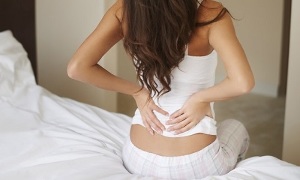
Low back pain is a symptom that can be related to a variety of medical conditions. They can be permanent or periodic, local or general.
If a person has pain in the lumbar spine, he will be assigned a thorough examination to determine the cause.
Possible Causes of Low Back Pain and Its Features
Back pain can have many different causes, depending on the degree of discomfort and the degree of discomfort. Pain syndrome reduces a person's quality of life, limits mobility and is unable to perform everyday tasks.
There are many causes of lower back pain. Some of them are quite serious and require the intervention of a specialist immediately.
Sciatica pain
Sciatica is a pathology of the musculoskeletal system, including compression and inflammation of the spinal roots. This pathology is of a secondary nature, as it develops on the basis of degenerative processes of the musculoskeletal system.
Common symptoms in this case are:
- Pain syndrome, worsened by sudden movement, lifting weights. The localization of pain depends on the degree of injury. The syndrome can affect the lumbar and buttocks area, the back or front of the thighs. If there is damage to the nerve endings below the first and second lumbar disc, then the patient has lumbar pain in the lumbar and buttocks.
- Increases pain level when coughing, sneezing.
- Not likely to stay in one position for long.
- Movement disturbances: inability to freely tilt the body forward, backward or to the sides, inability to bend fingers of lower extremities.
With spondylitis of the lumbar spine, pain usually comes on suddenly and stops spontaneously. The next time the pain becomes more acute, more pronounced.
Osteoporosis
Osteoporosis of the spine is a phenomenon where calcium leaching occurs from bone and the activity of cells responsible for bone growth is disrupted. Under such conditions, bones are rapidly destroyed, density is constantly decreasing. Osteoporosis is difficult to suspect in the early stages of development.
Usually, a patient feels a sharp pain in the lumbar spine when it is being stretched strongly - vigorously turning, falling, lifting weights.
In addition to severe low back pain, osteoporosis also has signs such as:
- chronic fatigue;
- bulging abdomen;
- impaired spinal mobility.
When compression fractures, caused by lumbar spine osteoporosis, there will be acute pain, which increases with palpation of the affected area, as well as muscle spasm.
Scoliosis curvature
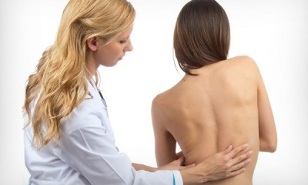
With lumbar scoliosis, its structures deviate to the right or to the left. These changes are reflected in the condition of surrounding tissues: they are irritated, there are inflammatory foci in the ligament-muscle structure.
Left scoliosis is the most commonly diagnosed. In left-handed people, scoliosis develops on the right side.
In the early stages, lumbar scoliosis may not appear in any way. Negative changes can only be determined by X-ray inspection.
The characteristic symptoms in this case, in addition to severe pain in the lumbar spine, are:
- slouch;
- swelling in the lumbar region;
- chest pain;
- displacement of the pelvis, so one lower limb becomes shorter than the other;
- lamellar divergence.
Characteristic features of pain in lumbar scoliosis: appears at the onset of physical activity, reduces the intensity of discomfort associated with walking. Pain is usually short-lived.
Injury
Lumbar cramps occur when falling or being hit. The lumbar region is most susceptible to injury.
Lumbar spinal effusion is a closed injury to tissues and part of the spine, not causing anatomical abnormalities. Most often this type of injury occurs in athletes, as well as people who work at work.
When bruising, the following additional symptoms are observed:
- hematoma formation;
- redness of the skin;
- increases pain when pressed against injured site.
If the condition is severe, the conduction of nerve impulses in certain areas of the lumbar spine may be disturbed, in some cases - complete loss of sensitivity.
Symptoms are more obvious for lumbar injuries and include the following:
- pain when probing the affected area;
- hematoma increasingly large;
- pain when turning, unable to bend;
- swelling in the ankle area, indicating poor blood circulation;
- paralysis and paralysis of the lower extremities.
Rheumatoid Arthritis
Rheumatoid arthritis of the spine is another possible cause of low back pain. In this case, joints located in this area are affected.
Pain from rheumatoid arthritis usually occurs at night, usually near dawn. In the early stages, the syndrome can be controlled with the help of special exercises, but at night the pain reappears.
Other symptoms: local increase in temperature in the affected area, accumulation of fluid in the cavities of the affected joint.
Osteochondrosis
Osteochondrosis is a pathological process in which discs lose elasticity. As the disease progresses, cracks form in them, a hernia forms.
In the early stages of osteonecrosis, low back pain rarely occurs and does not differ in intensity. In the future, they acquire a marked chronic personality. Patients feel stiff when moving, constantly tired. Difficulty arises in bending and widening the back.
Pain that usually spreads down the lower extremities. Parallel, tingling, numbness appeared.
An increase in the intensity of discomfort occurs with increased exertion, performing sudden movements, lifting weights.
Malignant tumor
If back pain is in the lower back it could be related to a serious medical condition like cancer. In this case, a malignant tumor does not necessarily affect the skeletal structure of the spine. In this case, the pancreas located behind the stomach can be affected, so the pain may sink in the lower back. Severe pain indicates stages of cancer development.
Also, pain in the lumbar region may be related to the fact that tumors of other organs have metastasized to the designated area.
In women, cramping back pain can be a sign of developing ovarian cancer. In men, strong and long-lasting contractions signal a prostate tumor.
Gynecological diseases
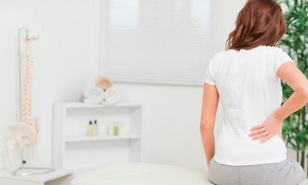
Women often worry about low back pain. A similar symptom can occur under the influence of such conditions:
- rupture of ovarian tissue;
- pathological processes of the uterus;
- cysts in the ovaries;
- cervical cancer;
- inflammatory processes of the fallopian tubes;
- benign formation on the inner wall of the uterus.
Low back pain most commonly occurs in women who have undergone a suspension of an artificial pregnancy. Discomfort is caused by mechanical damage to the tissues of the uterus and prolonged tightening of the wound.
In women with gynecological diseases, lumbar pain, spasms, aches and pains. In addition, irregular periods, loss of energy, irritability and increased body temperature. Usually, pain syndrome is complemented by secretions from the vagina.
Pain syndrome in this case is caused by hormonal imbalances and inflammatory processes spreading to the tissues of the lumbar region.
Kidney Disease
Lower back pain is a sure sign of kidney disease.
A similar symptom associated with such conditions:
- urolithiasis;
- pyelonephritis; glomerulonephritis
- ;
- nephroptosis (prolapse of the kidneys).
When there is a stone in the urinary tract, pain in the lumbar region is not too pronounced, of a dull nature. With inflammatory processes involving the kidneys, the pain is constant and painful. Its localization location in this case is on the left and right sides of the spine.
Acute pain is a manifestation of pain in the kidneys. The pain spread down the groin, inner thighs, anterior abdominal wall.
Other symptoms that may indicate kidney disease include:
- increased blood pressure;
- swelling of the hands, feet, and face that appears after waking up and disappears during the day;
- change when urinating: this process can be rapid and painful, or conversely, rarely, until complete cessation;
- comatose;
- increased sweating;
- anorexia.
Lumbar discomfort and pain is often associated with fetal pressure on the kidneys in pregnant women. In this case, the pain syndrome is not related to any pathology, it is a completely natural phenomenon.
Diseases of the male genital system
When sex gets stronger, low back pain often occurs with genital system diseases. Most often, discomfort is caused by inflammation of the prostate gland - an inflammatory process of the prostate gland. With this disease, urination and sexual function are interrupted. In addition to low back pain, there are pulling pain in the lower abdomen.
Another male disease that contributes to lumbar pain is epididymitis, an inflammation of the epididymis.
Lumbar myositis
Lumbar myositis is an inflammatory process of muscle tissue manifested by muscle pain and weakness, sometimes atrophy. The disease can be caused by infection, trauma, hypothermia, metabolic disorder in the body.
This pathology is characterized by:
- lower back pain that worsens with movement;
- a dull feeling of weakness in the muscles;
- swelling, redness of the skin.
Bone tuberculosis
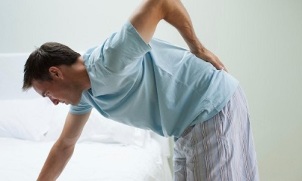
With spinal tuberculosis, the lower back often hurts. The nature of the pain syndrome in this case depends on the number of vertebrae involved in the pathological process, as well as the degree of deformation of the structures.
The main signs of spinal tuberculosis are:
- Severe pain in the lower back. This localization is related to the fact that the lumbar region is the largest part of the spine, where the maximum load is received.
- Increased nighttime sweating.
- Increases the size of the lymph nodes.
- The temperature increases in the range 37, 1-37, 3 degrees.
- Continuous fatigue.
With the progression of spinal tuberculosis, there is an angular curvature of this structure, the development of abscesses in the lumbar region and thoracic region.
The Climax
A decline in sexual function in women is often accompanied by low back pain. The same phenomenon, which is associated with a decrease in ovarian activity, is reflected in hormone estrogen levels. In the absence of it, bone tissue becomes more fragile and susceptible to damage.
In the context of hormonal changes, the musculoskeletal system generally becomes vulnerable: cartilage and disc becomes weaker, muscles and ligaments lose elasticity. Therefore, the lumbar region, where the pressure is always greatest, is at particular risk.
In addition to low back pain, menopausal women also experience headaches, sweat a lot, and hot flashes.
Vascular pathology
Violation of blood circulation, provoked by pathological vascular processes, can also cause pain in the lumbar region. Thrombophlebitis, atherosclerosis, and thrombosis contribute to the onset of pain syndrome.
The appearance of blood clots in the veins, inflammation of the vasculature, narrowing of the lumen - all of these interfere with the full flow of blood and thus limit the oxygen supply to tissues and structuresof the body, negatively affects their condition.
Other symptoms associated with vascular disease are swelling of the veins, severe extremities and bluish skin.
Intestinal diseases
With bowel diseases, the pain can spread down the lower back. This is because the intestinal tract takes up considerable space in the abdominal cavity. If any of its parts undergo pathological changes, then it develops, putting pressure on other organs. The spine is also at risk.
Pain extending to the lumbar region in case of ulcerative colitis, exacerbation of appendicitis, intestinal obstruction, irritable bowel syndrome.
In the case the pathological process spreads to the stomach, the pain is localized in the upper part of the lower back. They appear after a meal, as shown by a feeling of hunger, in the case of abuse of harmful products.
The following symptoms are observed in parallel:
- flatulence;
- stool disorder;
- colic.
Obesity
Being overweight puts extra strain on the spine, especially the lumbar spine. Constant pressure creates a risk of developing pathologies of the musculoskeletal system, causing trauma to the disc, scoliosis and the development of osteonecrosis.
In addition to the above conditions, lower back pain can be caused by driving or using the computer for too long, exercising too much, hobby of summer work and a sedentary lifestyle. moving.
Which doctor should I see?
Low back pain is usually caused by a serious disorder of the body, so it is necessary to see a doctor in time to properly diagnose the cause and treat.
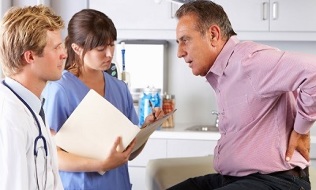
A specialist should be consulted if the patient has lower back pain:
- is regular;
- appears continuously after physical exertion;
- does not disappear while lying down;
- accompanied by numbness of limbs and increased body temperature.
The main therapists you should contact for back pain in the lumbar region are:
- chiropractor (for treatment of osteonecrosis and other neurological diseases); neuroscientist
- ;
- nephrologist (urologist): This specialist diagnoses and treats if lower back pain is related to pathological processes in the genitourinary system.
If necessary, other specialists will be involved in the diagnosis and treatment process: orthopedists, surgeons, gynecologists, oncologists and gastroenterologists.
Diagnosis
For pain in the lumbar region, the following diagnostic measures are prescribed:
- physical exam, determine history; Experiment
- to identify restricted nerve ends;
- blood test to assess hemoglobin level;
- myelography;
- X-ray of the spine;
- MRI;
- CT;
- ultrasound of abdominal organs;
- endoscopy, stomach, intestine;
- bone scintigraphy.
The activities listed allow to synthesize a complete picture of the patient's condition, identify the painful disease of the lumbar spine and determine the appropriate treatment schedule.
Backache treatments
The main treatment for low back pain depends on the cause of the symptom. Therapy aimed at eliminating the existing disease.
General Principles
Treatment is based on the following:
- the use of drugs to suppress inflammatory processes;
- performs physiotherapy procedures aimed at accelerating the recovery of affected structures; Physical therapy exercise
- .
During treatment, the patient must avoid active sports, as well as any physical activity, so as not to aggravate the course of the pathological process. During rehabilitation, the patient may be advised to practice yoga, swimming, or hiking to get some fresh air.
This therapy also includes dietary adjustments. The sick person should refuse to eat fatty foods, fried foods. It's important to give up bad habits - this will greatly speed up the healing process.
Medicines
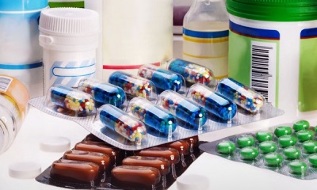
For pain in the lumbar region, the drug is usually prescribed in the form of an injection, which contains vitamin B. The task of these drugs is:
- accelerates the recovery of damaged nerve fibers;
- increases the functional activity of the central and peripheral nervous systems;
- speeds up metabolism.
For severe, intense low back pain, strong pain relievers are prescribed.
Nonsteroidal anti-inflammatory drugs to control inflammation are also administered by injection.
After one injection of nonsteroidal anti-inflammatory drugs, drugs of this group are prescribed in the form of tablets for oral administration.
For muscle spasms that cause low back pain, drugs like muscle relaxants are prescribed.
Patient is also prescribed external medication. They often have a warming effect and help relieve pain. They are prescribed only as part of a comprehensive treatment approach.
For pain in the lumbar region, a special ointment is recommended.
Gymnastics
A set of therapeutic exercises is prescribed only after the pain syndrome has subsided. In the period of exacerbations, therapeutic exercises are contraindicated.
For low back pain, do the following exercises:
- Lift the pelvis.You need to lie on your back and bend your legs at right angles. The pelvis should be gently lifted and returned to its original position. Repeat 10-15 times.
- Keep balance.This exercise is performed upright. You need to stand on tiptoes and try to balance in this position for about 10-15 seconds. Repeat 3-5 times.
- Raise your leg from a prone position.Lie on your back, alternately lift your lower limbs and straighten them as high as possible. Do 5-10 lifts for each leg.
- Moves on the buttocks.You need to sit on the floor with your back straight. Using the pelvis and buttocks, move forward, then back. You need to walk this way forward for about 2 m and back to the same amount. Number of hits is 2-3.
You must not exercise tools when you have spinal injuries, tumors and hernias, and if you have acute medical problems.
Physiotherapy
Physiotherapy procedures are performed provided that lower back pain is not caused by an acute inflammatory process. Acute pain syndrome is relieved first with conservative methods and only then with physical therapy.
For pain in the lumbar spine, the following procedures are prescribed:
- Magnetic therapy.This method improves blood circulation in the affected area.
- Electrophoresis.This method is necessary if you want to speed up the delivery of drugs to the lesion (pain relievers, nonsteroidal anti-inflammatory drugs, chondroprotectors).
- Laser therapy.This technique allows you to normalize metabolism and improve blood circulation in the affected areas.
Nutrition
To strengthen the bone elements, you should include cheese, dairy products and actually whole milk, fatty sea fish, black bread.
If the patient is overweight, putting additional load on the spine, it is necessary to exclude flour, sweets and sugary drinks from the diet.
Folk remedies
Traditional treatments should not become the primary treatment for low back pain. They are only an auxiliary method and are to be used only with the approval of the attending physician.
For back pain you can use the following traditional medicine formulas:
- Honey ointment.To make medicinal herbs, you need to take 3 tablespoons of natural wild honey to be melted in a water bath. Cool the product. Add 2 tablespoons of medicinal alcohol to honey, add 100 g of kerosene and rub on the sore areas. For a higher effect, you can apply it with this ointment. In this case, it is not rubbed against the skin, but spread it into a thin layer and put the adhesive film, and wrap it with a warm towel over it. Leave the gauze for 3-4 hours, then rinse with warm water.
- Compresses salt.Need to dissolve the table salt in hot water (ratio - 1: 10), stir well. In the finished solution, moisten a folded gauze cloth, cover the lower back with a gauze, wrap it with a towel and warm with a towel. Leave on overnight, remove the rest of the gauze in the morning.
- compressed garlic.You need to take 3 garlic bulbs, peel them, chop them. Pour the obtained mass with warm water (2 cups), leave on for 3 hours. During infusion, moisten a cotton cloth and sprinkle freshly squeezed lemon juice over the entire surface. Use a cold compress. Leave for 20 minutes until the damp cloth reaches body temperature. Then, repeat the application process. This can be repeated until the patient feels relief.
- Compress by content.You need to mix bodyagi powder with olive oil at the ratio of 1: 30. Lubricate the sore back area with the resulting composition, leaving the product on the skin for 40 minutes. After the specified time has passed, the product must be rinsed with warm water.
- Compresses dried burdock leaves.Wet the ingredients in boiling water, apply on your back, wrap a warm towel on top. Leave the compress for at least one hour.
- Bath with additive.Bathing can reduce the severity of the pain. As additives, 200 g of mustard powder, 600 ml of broth on mint leaves can work. Bath for 20 minutes. The water should be warm.

All of these treatments are aimed at relieving back pain i. e. they treat only symptoms.
Treatment of a specifically diagnosed disease should be carried out according to a separate program.
Precautions
To reduce the risk of low back pain you should:
- tracks your posture;
- stands and walks on straight back only;
- performs special exercises to strengthen the spine and back muscles;
- do not overload the spine, perform exercises using back muscles in moderation;
- avoids hypothermia;
- the better, participate in a sport that does not negatively affect the spine: swimming, yoga, walking are especially helpful;
- does not move suddenly when lifting the load;
- sleeps on a mattress of medium hardness, preferably - orthopedic type, pillows should also be orthopedic and of a moderate size;
- monitor weight, if necessary, diet and do special exercises to combat weight;
- takes a vitamin and mineral complex, especially during the period of hormonal changes in the body.
Back pain can not only be related to diseases of the spine, but also to dysfunction of internal organs. An expert can determine the real cause of the pain syndrome in diagnostic measures. Both the symptom itself and its cause need to be treated.



























